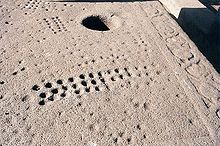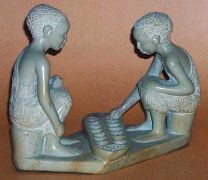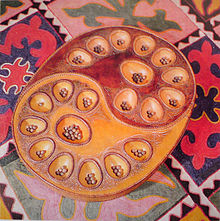Mancala

Mancala , also Manqala, Mankala ( Arabic منقلة, DMG manqala , derived fromنقل / naqala / 'transport, transport') is the generic term for board games that are usually played by two people, especially in Africa and Asia. It is characteristic that with them game pieces that lie in troughs are redistributed. In the English-speaking world, this type of game is also called Pit and Pebble Games (" Pit and Pebble Games ") or Count and Capture Games ("Counting and Catching Games"). In Germany they are known as bean games .
The first European to describe Mancala scientifically was Richard Jobson in the 17th century in his work The Golden Trade . The generic name Mancala was coined by the American ethnologist Stewart Culin , who wrote a scientific essay in 1894 on the worldwide distribution of these games. The name is derived from the Egyptian mancala game, which was first described in the west by the Englishman EW Lane in 1843. This game was played in many Cairo cafés in the first half of the 19th century.
Historical
The origin of the Mancala games is unknown. The oldest game boards include archaeological finds in the late Roman fort in Abu Sha'ar on the Red Sea in Egypt (4th century AD) and in Matara , Eritrea , and Yeha in northwest Ethiopia (6th-7th centuries AD). Chr.). The game itself was first mentioned in the Kitab al-Aghani ( Book of Songs ), which was written by Abu l-Faraj from Isfahan in the 10th century . Whether older rows of troughs ( called cup marks in archeology ) B. found in Egypt , Sri Lanka and Cyprus , game boards are not known. Even if these hollows were used for playing, you don't know what was actually played on them. The dating of such finds is also extremely problematic, as there are indications that some rows of hollows were created much later than the structures on which they are located. Nonetheless, amateurs and game producers keep claiming that Mancala is the oldest game in the world, "5000 years old".
With the slave trade , West African Mancala variants came to the West Indies (except Puerto Rico and the Bahamas ), the USA ( Louisiana ) and parts of South America around 1640 . With the spread of Islam , these games also reached Central Asia (e.g. Kazakhstan, Kyrgyzstan), India , the Maldives , southern China , southern Thailand , Malaysia and Indonesia . From there they eventually spread to Sri Lanka , the Philippines and the Mariana Islands .

In Europe , traditional Mancala variants have been described in the Baltic region, in the northern provinces of the former East Germany (Pomerania to East Prussia), in Bosnia and on the Greek Cycladic island of Hydra . There are two Mancala tables from the early 18th century in Weikersheim Castle in Baden-Württemberg.
Tournaments are mainly for the following games:
- Oware (Ghana, Ivory Coast, Nigeria, Great Britain, France, Spain, Switzerland, Czech Republic, Canada, USA, Antigua)
- Songo (Cameroon, Gabon, Equatorial Guinea)
- Toguz Korgool / Togus Kumalak (Kyrgyzstan, Kazakhstan, Germany, Czech Republic, Russia)
- Congkak / Sungka (Malaysia, Indonesia, England, USA)
- Kalaha (USA, Germany, Scandinavia)
- Mangala (Turkey, Syria)
- Bao La Kiswahili (Tanzania, Kenya, Malawi, Netherlands)
- Omweso (Uganda)
- Kiela (Angola)
- Moruba (South Africa)
- Hawalis (Oman)
Names and Variants
Over 800 names of traditional Mancala variants are mentioned on the Internet; some name the same games, on the other hand, different games often have the same name. There are now almost 200 modern variants, most of which were only invented in the last 50 years. Altogether there are probably well over 1000 different games.
Most Mancala games have two, three or four parallel rows, each consisting of one (Nano-Wari) to 50 hollows (En Gehé). In some variants there is also a large trough at both ends in which the stones are collected. In China (Yunnan Province) there is also a five-row version (Laomuzhuqi) and in Madagascar there is even a six-row game (Katro). In addition, several single-row mancala games have been invented in the USA and Germany (Atomic Wari, Sowing , 55Stones, Progressive Mancala).
Most of the Mancala variants are about either hitting the most stones or disabling the opponent. There are also games in which the player who cannot draw first, wins. In some games (e.g. Bao la Kiswahili, Omweso, Kisolo) a certain position on the board should be reached.
Here are the names of traditional variants and their region of distribution:
| Name or variant | Distribution region |
|---|---|
| Adji-boto | Surinam |
| Ai-ú | Brazil |
| Ajua | Kenya |
| Awele | Ivory Coast |
| Ayo | Nigeria |
| Bao La Kiswahili | Tanzania, Kenya, Mozambique, Comoros, Madagascar |
| Bawo | Malawi |
| Bean game | Germany, Baltic States |
| Ceelkoqyuqkoqjji | China / Yunnan |
| Cenne | Karnataka (India) |
| Chisolo | Zambia |
| Conklak | Indonesia, Singapore, Malaysia |
| Dakon | Indonesia / Java |
| En Dodoi | Tanzania |
| En Gehé | Tanzania |
| Gabata | Ethiopia, Eritrea |
| Giuthi | Kenya |
| Halusa | Iraq |
| Hawalis | Oman |
| Hoyito | Dominican Republic |
| Hus | Namibia |
| Isolo | Zambia |
| Katro | Madagascar |
| Kay | Haiti |
| Kiela | Angola / Luanda |
| Kiothi | Kenya |
| Kisolo | Congo |
| Krur | South Morocco |
| Laomuzhuqi | China / Yunnan |
| Layli Goobalay | Somalia |
| Mak khom | Thailand |
| Mandoli | Greece / Hydra Island |
| Mangala | Turkey |
| Mangola | Congo |
| Mankalah | Egypt |
| Moruba | South Africa |
| Nsolo | Malawi, Zambia |
| Ô To Quan | Vietnam |
| Ohvalhu | Maldives |
| Olinda | Sri Lanka |
| Omweso | Uganda |
| Ouri (l) | Cape Verde |
| Oware | Ghana |
| Owela | Namibia |
| Pallanguzhi | Sri Lanka, South India |
| Qelat | Eritrea |
| Sadeqa | Ethiopia |
| Selus | Eritrea, Ethiopia |
| Songo | Cameroon |
| Sungka | Philippines |
| T (s) chuba | Mozambique, South Africa |
| Tchadji | Mozambique |
| Tchonka | Mariana Islands |
| Toguz Korgool | Kyrgyzstan |
| Togyz kumalak | Kazakhstan |
| Tsoro | Zimbabwe |
| Walak-pussa | Sri Lanka |
| Warra | USA / Louisiana |
| Warri | Antigua & Barbuda |
| Wauri | Grand Cayman |
| Wa-wee | Santa Lucia |
| Zigulzoqge | China / Yunnan |
| Ouril | Cape Verde |
Cultural characteristics

Many mancala boards are artistically carved from wood and today decorate the exhibitions of ethnological museums all over the world. However, children or nomadic cattle herders often just dig hollows in the ground. The game pieces are seeds (especially those of the Moluccan bean Caesalpinia bonduc ), clams, balls of feces (from camels, goats, sheep) or pebbles. In Ghana it is said that Ntim Gyakari (1695–1701), the king of Denkyira, used gold tokens when he was murdered in a game of Oware . Since then it has been said in West Africa that golden stones bring bad luck.
The symbolic meanings of the traditional mancala games are many. Often they are related to the desire for “fertility”, depending on the social background e.g. B. with the pregnancy of women and cows, the stealing of cattle, the catching of fish, the rain cult, the cycle of sowing and reaping, the acquisition of wealth through trade.
The twelve hollows, which have many variants, are interpreted in some areas as the twelve months or the twelve signs of the zodiac .
In Ivory Coast , where it is called Awele , the game was only played during the day. At night it was left outside so that the gods could continue playing. In Suriname , the bereaved relatives play the game called Awari before the funeral to please the deceased. It was believed there that at night the Yorkas , the spirits of the dead, came to play along and to abduct the souls of the living into the realm of shadows.
In many areas of Africa and the Caribbean, only men are allowed to play. In South Asia, on the other hand, it is mostly a game played by women and children. In Central Asia it was originally a men's game, but Toguz Kumalak in particular achieved the status of a national sport in the republics there during the Soviet era, which is also practiced by many women.
Mathematical investigation
For the Awari game with 4 beans in each well, computer scientists John W. Romein and Henri E. Bal from the Free University of Amsterdam showed in 2002 through massive computer calculations that the game ends in a draw for perfect players.
literature
- Jürgen Zwernemann: The Mankala game with the Fon and Ewe. In: Afrika und Übersee: Sprachen, Kulturen, Volume 66, No. 1, 1983, pp. 141–147.
Web links
Individual evidence
- ↑ Online version of the article in the Elliott Avedon Museum and Archive of Games ( Memento of November 24, 2005 in the Internet Archive ) (University of Waterloo, Canada)
- ^ Clifford Pickover, Math Book, Sterling Publ. 2012, p. 506

